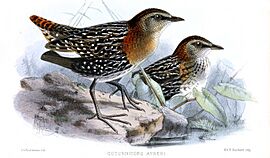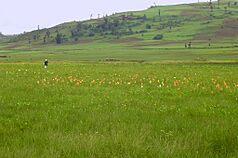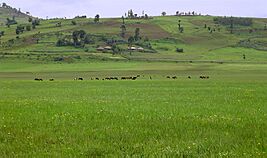White-winged flufftail facts for kids
Quick facts for kids White-winged flufftail |
|
|---|---|
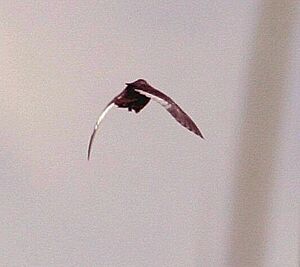 |
|
| In Mpumalanga, South Africa | |
| Conservation status | |
| Scientific classification | |
| Genus: |
Sarothrura
|
| Species: |
ayresi
|
| Synonyms | |
|
|
The white-winged flufftail (Sarothrura ayresi) is a very rare African bird. It belongs to a bird family called Sarothruridae. Scientists believe there are fewer than 250 adult white-winged flufftails left in the world. These special birds live in two main areas: Ethiopia and South Africa. It's still a mystery whether these groups are part of one big population or two separate ones.
Both male and female white-winged flufftails have feathers that aren't very bright. They have dark tops on their heads. When they fly, you can see their white feathers on the middle part of their wings, which is a unique feature!
Their habitat is a special kind of wet grassland found high up in the mountains. These areas are called seasonal marshlands. They have lots of tall sedge plants, which help hide their nests on the ground. Losing their habitat is the biggest problem for these birds because they need this very specific type of home. These marshlands are disappearing because of things like farming, animals grazing, and people collecting sedge. However, some people are working hard to protect the white-winged flufftail.
Contents
About the White-winged Flufftail
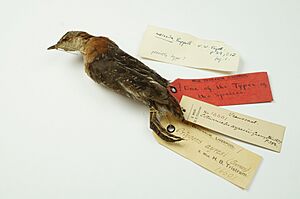
This bird's scientific name honors a South African bird expert named Thomas Ayres. He was the first person to discover this bird in a place called Potchefstroom.
The white-winged flufftail looks a lot like its relatives in the Flufftail group. Both male and female flufftails have dull feathers and dark crowns (the top of their heads). When they fly, both sexes show off their special white feathers on the middle part of their wings. Only one other bird group, Coturnicops, shares this feature.
When these birds are not breeding, they usually call only at sunrise and sunset. Sometimes, they even sing together in a duet!
All birds in the Flufftail group live in Africa. But out of all of them, the white-winged flufftail is the most endangered.
Where Do White-winged Flufftails Live?
This bird seems to live in two separate areas. You can find them north of the equator in Ethiopia, and south of the equator in Zambia, Zimbabwe, and South Africa. For a long time, people thought they only bred (had babies) in Ethiopia. But in 2018, they were seen breeding in South Africa too! Still, scientists aren't sure if the northern and southern groups are truly separate or if they are one big population that travels between these places.
Some things suggest they might be one big group that mixes together:
- They all look exactly the same.
- New research shows their genes for fighting off sickness are very similar.
- There are only tiny differences in their mitochondrial DNA, which is a special kind of DNA.
However, even with these similarities, the DNA also hints that the two groups might slowly be becoming separate over time.
On the other hand, some evidence suggests the northern and southern groups are different:
- Even small differences in mitochondrial DNA can mean birds are different subspecies. Other bird subspecies, known to be separate (for example, because land keeps them apart or they look different), also have only small DNA differences.
The reason we don't know for sure about the white-winged flufftail's population is because it's a very rare bird, and not much research has been done on it.
White-winged Flufftail Habitat
These birds need a very specific type of home. Their natural habitat is a special kind of wet grassland found high up in the mountains. These areas are called seasonal marshlands. The soil in these regions is often peaty, which helps grow the sedge plants that are common in these marshlands.
The white-winged flufftail is a visitor to these highland marshes south of the equator, usually only during the summer. They don't stay in any one place for long. Sometimes, they leave after just six weeks if the conditions in the marsh become bad.
The three main places in Ethiopia where they are found are the Suluta Valley wetlands, the Berga wetlands, and the Wersebi wetlands, all near Addis Ababa. The first time they were confirmed to breed was at the Berga wetlands in 1997. Breeding has also been seen at the Wersebi wetlands and the Bilacha river wetland, which might be their main breeding spot. In South Africa, they are regularly seen at the Dullstroom and Wakkerstroom marshes. Public access to these areas is carefully controlled to protect the birds.
Reproduction and Life Cycle
Scientists believe the breeding season for white-winged flufftails is from June to September. This is when they have been seen in their breeding areas. It's also the time when the rainy season starts, which helps create the right conditions for breeding.
These birds usually lay about four to five eggs. They build their nests on the ground, hidden among the plants. These ground nests can be in danger from people or farm animals walking by.
They likely choose their nest spots based on how tall the plants are and how deep the water is. They prefer areas with tall, mixed sedge plants and shallow water.
Protecting the White-winged Flufftail
The white-winged flufftail is in serious danger because it is losing its habitat. This happens for many reasons, including:
- Cattle trampling on the grass.
- People cutting the grass.
- Draining swamps to create pastures for animals.
- Flooding from dams.
- New houses being built.
- Soil wearing away (erosion).
If land is managed carefully, it could greatly improve the situation for these birds.
In Ethiopia, more and more people mean more pressure on the land. This leads to more crop farming, too many animals grazing, and people harvesting sedges to feed their livestock. Sedges are very important for the white-winged flufftail's habitat. People also collect sedges for a local coffee-making tradition. When humans change these wetlands by taking water or letting animals graze too much, it changes the wetlands and harms the local animals, including the flufftail. In 1997, it was thought that about 550 hectares (about 1,360 acres) of good habitat were available for 210-215 breeding pairs in Ethiopia. But by 2020, only 232 hectares (about 570 acres) were estimated to be home to just 55 breeding pairs.
The upper Berga wetlands used to have the best habitat for nests, but it is now threatened by habitat fragmentation, meaning the habitat is being broken up into smaller pieces. The Weserbi wetlands are no longer suitable for the birds because of farming practices that are not sustainable. The Bilacha wetlands are also at risk of becoming unsuitable.
The upper Berga wetlands should be a top priority for conservation efforts in Ethiopia. Even though groups like Ethiopian Wildlife, Natural History Society, and Middelpunt Wetland Trust have tried to help, the Weserbi wetland had its last white-winged flufftail sighting in 2003.
Gallery



